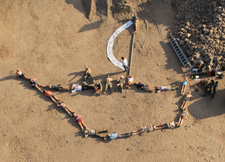Romanization
 The last of the great cultural transformations of the ancient world - the
Christianization of Rome - might be seen as the come-uppance of eastern philosophy in
the age-old struggle between East and West. The rise of Christianity was not a lone
phenomenon, however. Several Gnostic eastern religions were vying for supremacy in the
Roman world during the second and third centuries CE.
The last of the great cultural transformations of the ancient world - the
Christianization of Rome - might be seen as the come-uppance of eastern philosophy in
the age-old struggle between East and West. The rise of Christianity was not a lone
phenomenon, however. Several Gnostic eastern religions were vying for supremacy in the
Roman world during the second and third centuries CE.
When John Garstang excavated at Dor in the nineteen-twenties, he uncovered two massive
structures on the west side of the tell. He interpreted the northern building as a Ionic
prostyle temple, of an orthodox Greco-Roman design, and dated it to the early
Hellenistic period. This view of the Dor temple might illustrate the simplistic
conception of a straightforward takeover of local religions by Hellenism.

Investigations by the present expedition have turned this picture around. First, the
temple is not a Hellenistic foundation, but a Roman one. In fact, it is the latest
major urban innovation at Dor, perhaps dating to the brief Severan revival, in the
beginning of the 3rd century CE. Second, the excavators were able to demonstrate that this
temple was not of canonical design. The integration of Hellenistic or Roman attributes
(in this case - Ionic colonnades) into non-Hellenic cults is one of the
characteristics of sacral architecture in the eastern Roman empire.
